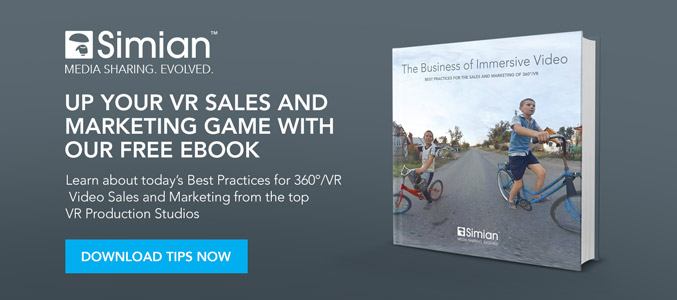In the world of 360º/VR video, life definitely imitates art with freshly-imagined, cutting-edge technology and ways to package, share and distribute this amazing and rapidly growing medium. Since launching Simian’s complete 360º/VR support, we decided it was time to take a closer look at the trend as a whole.
The VR Download is Simian’s four-part series designed to expose the inside track from the experts on what’s next for 360º/VR video, along with the current challenges and potential solutions on the horizon.
About VRTÜL
VRTÜL (pr. Virtual) is a Virtual Reality production studio and content solutions company based in San Diego and Los Angeles; specializing in the supervision, filming and post-production of premium 360 degree Stereo Virtual Reality (VR) content.
Contributors:
Casey Sapp, Founder
Matt DeJohn, Head of Production
Mary Ida Bonadio, Marketing Director
Simian: 360º/VR video is a hotter than ever. How have things changed over time? Has gear like the Oculus Rift and HTC Vive made an impact on the demand for this type of content?
Casey: Simian is addressing one flavor of Virtual Reality with 360º Video, but there are many others. Each of these options requires different skill sets, different applications and uses. Going forward, we want to expand our reach beyond 360º Video to other types of VR with options like Oculus and HTC that provide powerful, distinct types of Virtual Reality. This is important if say, a zoo wants to give people the ability to go inside the exhibit and actually pet the animal, walk around with the animal or play with the animal. These actions require a much different experience than 360º video, which is hyper realistic with only passive engagement. Both are great options, but very different in terms of development and in consideration for development.
As for HTC Vives, with less than twenty-five thousand on the market currently and a million people who put on a Samsung Gear VR last month to watch an experience, there’s a huge difference in numbers right now.
Simian: What makes VR such a unique storytelling experience?
Casey: Since I came from a background in education, I had always cared about access to information. Images, videos, search results…you can find that “right answer” anytime you want. The new future, the new frontier and what companies really care about today is access to experience. Access to experience is how you bring people inside of a story. It’s how you help them identify and connect. I feel that as a VR filmmaker, I’m in the business of creating emotion and that’s really important for what we do. Are you going to scare someone or inspire them? Scientifically speaking, in your brain, VR accentuates that more than in a traditional, flat screen film.
Your brain takes in the Virtual Reality experience like an actual experience, so were definitely in the business of experience and emotion. This is an exciting experience for learning, native branding, storytelling, fundraising and commercials, because you don't feel like you're on the outside, you feel like you are right in the thick of it.
Simian: How is the issue of proximity impacting your current projects?
Casey: Part of the game for filmmakers is a camera setup that’s not obtrusive, but still captures the most vital, visceral moments. In that moment, how do you get close enough without being too close? There is this very hard/sweet spot between three and fifteen feet that you have to tell a story. Too close and it’s impossible to produce and too far away, people won’t care.
We’re working on a project right now with camera placement inside of animal enclosures at a zoo. The challenge is, how do you fit a custom rig that's reliable, resilient and can handle pressure but is also solvable? For this, we created a custom rig that used GoPro hard cases. This way, if the animal grabs at it, the camera will be safe, but it poses challenges from a lens perspective. The hard case is a bit difficult to handle production-wise, but we have to push the limits and get creative on how we protect the cameras in order to place them where they need to be. It’s part of the storytelling experience and putting someone’s eyes in that space.
Simian: Can you elaborate a bit more on the importance of space in 360º/VR?
Casey: Space is vitally important. The story can be extremely powerful, but no one will care unless they understand why they are there. If you can answer the why, you can tell that story. When you can actually transport them to the New York Stock Exchange, to top of the Empire State Building or inside of an animal exhibit, it really pulls down barriers. Traditional film doesn’t always capture space the way 360º does. It captures very natural moments and can't be scripted.
Simian: Where do you think VR makes the biggest impact?
Casey: I care about education and as research has proven with pilot simulations for the last 30 years, VR helps to better prepare people for a career and to learn more deeply with better learning outcomes. As more research emerges, we will be partnering with some big education companies to integrate VR headsets into classrooms, so students can be transported to anywhere in the world.
Even though Math and many other subjects haven't changed for hundreds of years, if you can make them more engaging, people may learn in a new way that compels them to want to go deeper. We’re striving to reinvent learning, so that people want to learn as opposed to feeling forced to. VR does this really well, but it's going to be a slow process.
Lastly of course, gamers are going to pick it up because they don't care about ROI, learning outcomes or cost, they're doing it because it’s fun.
Budget, Technology and Standards
Simian: Because there are no universal standards, what are the challenges with different camera formats, supporting browsers, etc.?
Casey: It’s brutal. We recently shot almost 3TB of footage in less than three hours and when you actually compress the final edited file, it’s still going to be over a gig. So, if someone wants to make an edit (and they don't live next to you), you actually have to upload the entire 360º experience, which, takes a couple hours. Then, once they watch it and make a couple recommendations or comments, you re-upload another gig and a half which takes another couple hours…and so on. Editing happens over many, many days and it is a very time consuming process.
Matt: The actual capture, quick stitch and final stitch is a time consuming thing. Once you get through the final editing with the material, it’s not so bad. While uploading edited material is not significantly more difficult than traditional new video, with 4K, graininess is sometimes detected. This can result in an upload hit, but not as extreme as with raw data.
Like what you’ve read so far? You might also be interested in: Simian 360º/VR Video Cloud Sharing
Simian: You primarily use GoPro. What are some of the other options and setups?
Matt: GoPro is either in a six camera arrangement or ten camera arrangement that will do 2D. We also frequently use a fourteen camera arrangement and occasionally more. There are other camera systems like the Nokia OZO, a pretty popular pro-grade system and on the lower side the Kodak SP360º, a kind of a dual 180º lens camera system. Beyond that, there are custom cameras that use the Blackmagic Micro Cinema Camera body, RED or even Sony Mirrorless, so it’s a little bit of everything goes when it comes to cameras. Right now, main go-to cameras are GoPro-based and at a higher level, Nokia-based for building custom.
Simian: How do budgets and deadlines differ from traditional video? Does it take more or less time to complete a VR project?
Matt: In general, timelines are longer and budgets are higher. Even though all the steps of the process are the same (editing, sound, shoot, etc.), there are additional processes that do not necessarily exist in traditional video production (quick stitch and final stitch). In addition, there’s significantly more data and processing time involved in VR production and post production and the equipment costs are also higher (for similar quality), since there are multiple cameras involved.
The Future of 360º/VR Video
Simian: What does the future of VR look like? In the long run, do you think VR Video will become a mass or niche market?
Mary Ida: I think that Millennials will embrace it the most. It is already evolving, so I don't think it’s a niche market, but rather a new way of viewing things. If anything, as technology catches up to the narrative or the ideology, it will be common place much like the evolution of television with higher definition and portability via phones and computers. It’s an untapped resource and I think that once accepted, it’s here to stay.
Simian: What software and technology will help with the future of VR production? What do you want to see from vendors?
Matt: More advanced final stitching tools and software will be helpful for VR production. Better/Pro-grade VR camera solutions that have full camera sync, monitoring, manual controls, etc. will be essential for future productions.
Stay tuned for more from the experts at VRTÜL on the production and post side of 360º/VR video in our next installment….
Have a question or some great feedback to share? Let us know on Twitter or Facebook – we’d love to hear from you!
MORE FROM THE SIMIAN BLOG

Up Your Game with Microsites
An industry first, Simian Microsites not only offer creative, marketing, advertising and production teams a better wa...

Cannes Lions Survival Guide
The countdown to Cannes is on! Once again, we feel it is our civic duty to help onboard newbies and enlighten crafty ...

What Makes a Great Director?
As a video production company, wouldn’t it be great to hear straight from the leading executive producers and manag...



